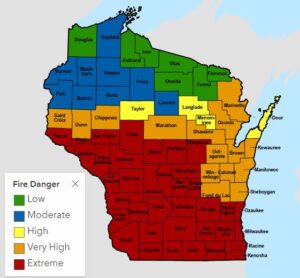
This 2022-23 winter — December through February — was exceptional in that it was Wisconsin’s wettest meteorological winter on record, and those records go back to 1895.
The state also experienced significant snowfall in March. When the snow slowly melts into the soil, it provides needed water for plant growth.
Fires require fuel to burn, air to supply oxygen, and a heat source to get the fuel to its ignition temperature. Regardless of how much snow fell during winter, if we have a few days of hot, dry and windy weather in early spring, vegetation will dry out, providing fuel to burn if ignited.
A wet winter also can become a wildfire problem later in the summer. The snowfall provides moisture for plant production. A summer drought can kill plants, leaving behind a fuel source for a fire.
This past week, Wisconsin and other northern states were under a red flag warning. The National Weather Service issues a red flag warning when warm temperatures, very low humidity and strong winds are expected. These weather conditions combine to produce an increased risk of a fire and the warning alerts fire officials and firefighters of potentially dangerous conditions within the next 12 to 24 hours. High winds also help spread the fires. Red flag conditions also alert the public to be cautious and not ignite a fire.
NWS issuance of a red flag warning is based on wind speed, humidity and how dry the ground is, but exact thresholds vary by region. In Wisconsin, these conditions generally occur in the springtime before plants green up and in the fall before there is snow on the ground.
Steve Ackerman and Jonathan Martin, professors in the UW-Madison department of atmospheric and oceanic sciences, are guests on WHA radio (970 AM) at 11:45 a.m. the last Monday of each month. Send them your questions at stevea@ssec.wisc.edu or jemarti1@wisc.edu.

